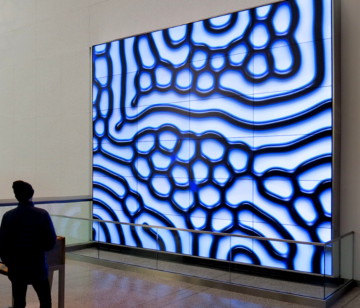Try the related web application: RD Tool


2016, Karl Sims
|
Emergent dynamic patterns are displayed on a high resolution wall of
24 screens. This exhibit was shown at the
Museum of Science, Boston from 2016
to 2024 in the main lobby of the museum.
Try the related web application: RD Tool
|

|
Two simulated chemicals, shown as white and dark blue, react and
diffuse to generate biological-looking patterns and shapes. A
touch-screen kiosk in front of the display allows visitors to adjust
parameters and create a wide range of different results.
The user-interface controls provided are as follows:
Pattern shape
A cursor is positioned on a map to select the type of pattern. The center image below shows the pattern map, and the four images around it are some examples that might occur on the video wall from the given positions on the map. A new pattern grows from the previous pattern, so moving the cursor from one position on the map to another can give many unique results.

The vertical axis on the pattern map controls the "feed" rate, or how much of the white chemical is continuously added to the simulation. Lower positions often create more dynamic behaviors because the darker shapes need to keep moving to find enough food. The horizontal axis roughly controls the "kill" rate. Left positions give the dark chemical a longer life span and those shapes tend to grow. Right positions give it a shorter life span and the darker shapes tend to shrink or only grow at their ends.
|
Size
This slider adjusts the scale of the entire pattern, from small to large. Different scales are achieved by speeding up or slowing down the diffusion rate relative to the reaction rate in the simulation. |

|

|
Orientation
The diffusion can occur faster in one direction than another to give an orientation to the results. The left setting of this slider gives a random field of orientations and can make swirl shaped patterns such as a fingerprint. The center setting of this slider gives no specific orientation to the pattern, and the right setting gives a radial effect so the orientations align outwards from the center.

|

|

|
Regrow pattern
This button clears the screen and grows a new pattern starting with a seed at the center. The current pattern, size, and orientation settings determine the specific result. Most settings cause the pattern to grow and eventually fill the screen, although some pattern map positions may grow slowly or not at all.

|

|

|
Natural patterns simulated
Several buttons are provided that give predetermined examples resembling a fingerprint, tree rings, brain coral, or cheetah spots. When these buttons are pressed, the pattern, size, and orientation controls automatically slide to new positions to give that preset result. The screen is also cleared and the new pattern is grown from a seed at the center.
|
Acknowledgments
The reaction-diffusion simulation was developed by Karl Sims using C and OpenCL and runs on a Linux workstation with an NVIDIA GTX 980 GPU. Jesse Gray of IF Robots implemented an initial prototype of the user-interface. The final touch screen interface was developed by the Museum of Science, Boston, whose team included Chris Brown, Jane Jolkovski, Malorie Landgreen, Chelsea Murphy, Emily O'Hara, Keith Simmons, and Ben Wilson.
Try this RD Tool web application to experiment with reaction-diffusion simulations.
|

| |

|

Photo © Studio Nouveau
|
Back to other work by Karl Sims.
© 2016, Karl Sims, All rights reserved.